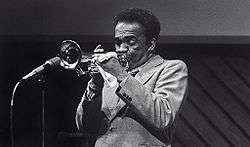Howard McGhee
| Howard McGhee | |
|---|---|
|
Rochester, New York, 1976 | |
| Background information | |
| Born |
March 6, 1918 Tulsa, Oklahoma, U.S. |
| Died |
July 17, 1987 (aged 69) New York City, New York |
| Genres | Jazz |
| Occupation(s) | Musician |
| Instruments | Trumpet |
| Labels | Dial |
| Associated acts | Lionel Hampton, Andy Kirk, Count Basie |
Howard McGhee (March 6, 1918 – July 17, 1987) was one of the first bebop jazz trumpeters, with Dizzy Gillespie, Fats Navarro and Idrees Sulieman. He was known for his fast fingers and very high notes. What is generally not known is the influence that he had on younger hard bop trumpeters, with Fats Navarro.
Biography
Howard McGhee was raised in Detroit, Michigan. During his career, he played in bands led by Lionel Hampton, Andy Kirk, Count Basie and Charlie Barnet. He was in a club listening to the radio when he first heard Parker and was one of the early adopters of the new style, a fact that was disapproved by older musicians like Kid Ory.
.jpg)
In 1946–47, some record sessions for the new label Dial were organized at Hollywood with Charlie Parker and the Howard McGhee combo. The first was held on July 29, 1946. The musicians were Charlie Parker (as), Howard McGhee (tp), Jimmy Bunn (p), Bob Kesterson (b), and Roy Porter (d). The titles played were "Max is Making Wax", "Lover Man", "The Gypsy" and "Be-bop".
McGhee continued to work as a sideman for Parker. He played on titles like "Relaxin' at Camarillo", "Cheers", "Carvin the Bird" and "Stupendous". His stay in California was cut short because of racial prejudice, particularly vicious towards McGhee as half of a mixed-race couple.[1]
Drug problems sidelined McGhee for much of the 1950s, but he resurfaced in the 1960s, appearing in many George Wein productions. His career sputtered again in the mid-1960s and he did not record again until 1976. He led one of three big jazz bands trying to succeed in New York in the late 1960s. While the band did not survive, a recording was released in the mid-1970s.
He taught music through the 1970s, both in classrooms and at his apartment in midtown Manhattan and instructed musicians like Charlie Rouse in music theory. He was as much an accomplished composer-arranger as he was a performer.
Discography
.jpg)
As leader/co-leader
- 1946–7 Trumpet at Tempo (Dial) released 1996
- 1948 Howard McGhee and Milt Jackson (Savoy) released 1955
- 1955 The Return of Howard McGhee (Bethlehem)
- 1956 Life Is Just a Bowl of Cherries (Bethlehem)
- 1960 Dusty Blue (Bethlehem)
- 1961 Together Again!!!! (Contemporary) – with Teddy Edwards
- 1961 Maggie's Back in Town!! (Contemporary)
- 1961 The Sharp Edge (Fontana)
- 1963 Nobody Knows You When You're Down and Out (United Artists)
- 1963 House Warmin'! (Argo)
- 1976 Here Comes Freddie (Sonet) – with Illinois Jacquet
- 1976 Just Be There (SteepleChase) with Horace Parlan, Kenny Clarke
- 1977 Jazzbrothers (Storyville)
- 1978 Home Run (Storyville)
- 1979 Wise in Time (Storyville)
As sideman
With Dexter Gordon
- Bopland: The Legendary Elks Club Concert, L.A. 1947 (Savoy Jazz, 2004)
With Johnny Hartman
- Songs from the Heart (1955)
- All of Me: The Debonair Mr. Hartman (1956)
With James Moody
- Cookin' the Blues (Argo, 1961)
With Don Patterson
- Boppin' & Burnin' (Prestige, 1968)
With Joe Williams
- At Newport '63 (RCA Victor, 1963)
References
Further reading
DeVeaux, Scott (1997). The birth of bebop : a social and musical history. Berkeley: University of California Press. ISBN 9780520216655.
